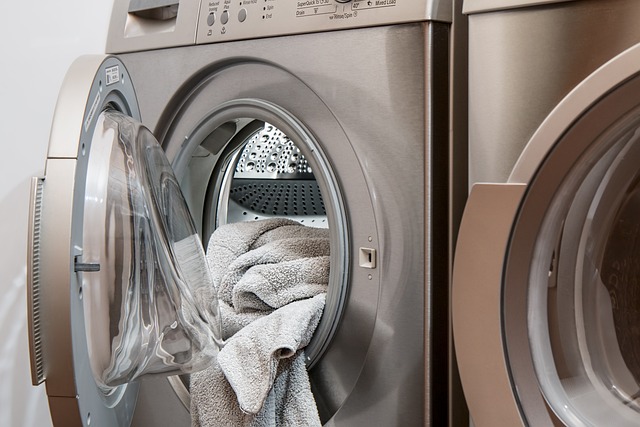As an Amazon Associate I earn from qualifying purchases.

To wash clothes at night, follow these steps:
Gather your dirty clothes and separate them into different loads based on color and fabric type.
Gathering your dirty clothes is the first step in washing clothes at night. Before starting, it is important to collect all the clothes that need to be washed and bring them to the laundry area. This includes checking pockets for any items that need to be removed, such as tissues, coins or other items that could cause damage to the washing machine.
Once you have gathered all the dirty clothes, the next step is to separate them into different loads based on color and fabric type. This is important to prevent color bleeding, which occurs when the dyes from one piece of clothing transfer to another during the washing process. To avoid this, separate clothes into light and dark loads, and be mindful of items that may bleed, such as reds or bright colors.
In addition to separating by color, it is also important to separate clothes by fabric type. Delicate fabrics, such as silk or lace, need to be washed on a gentle cycle with cold water and a mild detergent. On the other hand, heavy-duty fabrics, such as denim or canvas, can handle a more aggressive wash cycle with hot water and a stronger detergent. Proper separation of your clothes will ensure that they are properly cleaned and protected during the washing process.
Fill the washing machine with the appropriate amount of detergent for the size of the load.
Filling the washing machine with the right amount of detergent is crucial for effectively cleaning your clothes and keeping them in good condition. The amount of detergent you use should be based on the size of the load, the type of detergent, and the hardness of the water.
Too little detergent can result in clothes that are not thoroughly cleaned and can leave them with a musty odor. On the other hand, too much detergent can lead to an excessive amount of suds, which can leave residue on your clothes and damage the washing machine.
To determine the appropriate amount of detergent, refer to the manufacturer’s instructions or the care label on the detergent packaging. For standard loads, a general guideline is to use about 1-2 tablespoons of liquid detergent or 1-2 teaspoons of powder detergent. For larger loads, you may need to use more.
It is also important to use the right type of detergent for your clothes. For example, using a detergent specifically designed for delicate fabrics is recommended for washing delicate items.
In conclusion, by following these guidelines, you can ensure that your clothes are effectively cleaned and protected while being washed in the washing machine.
Place the clothes in the machine, making sure not to overload it.
When placing clothes in the washing machine, it’s important to make sure not to overload it. Overloading can cause clothes to become tangled, not clean thoroughly, and even damage the machine. It’s best to follow the manufacturer’s guidelines for maximum load capacity.
A general rule of thumb is to fill the machine about three-quarters full. This allows clothes enough room to move and ensures a thorough wash. If you have a lot of clothes to wash, it’s better to split them into smaller loads rather than trying to wash them all at once.
It’s also important to evenly distribute the clothes in the machine. Avoid stacking all the clothes in one corner or piling them on top of each other. This can lead to areas of the machine not being cleaned, and some clothes not getting washed properly.
By making sure not to overload the washing machine, you can help to ensure a thorough, effective wash for your clothes.
Set the water temperature and wash cycle according to the care labels on your clothes.
Setting the water temperature and wash cycle according to the care labels on your clothes is important for keeping them in good condition and extending their lifespan. Each garment has specific instructions on how it should be washed and the appropriate water temperature to use. This information is usually listed on a tag attached to the garment and is represented by symbols.
For example, if a garment has a symbol that shows a washing machine with cold water, it should be washed in cold water. On the other hand, if the symbol shows a machine with warm water, it should be washed in warm water. The same goes for the spin cycle speed, the length of the wash cycle, and the agitation level. By following these instructions, you can avoid shrinking, fading, or damaging your clothes.
It is important to remember that not all clothes can be washed in the same way. Delicate fabrics like silk, lace, and cashmere require gentle wash cycles and low spin speeds, while sturdy fabrics like denim and canvas can handle more agitation and longer wash cycles. By setting the water temperature and wash cycle according to the care labels on your clothes, you can ensure that your clothes are cleaned effectively and protected from damage.
Start the washing machine and let it run until the cycle is complete.
Starting the washing machine is a simple process. Most washing machines have a button or dial that you can turn to start the machine. You may need to select the wash cycle and water temperature based on the care labels on your clothes. Once these settings are selected, you can start the machine by pressing the start button.
It’s important to let the washing machine run until the cycle is complete. This ensures that your clothes are thoroughly cleaned and rinsed. The length of the cycle will depend on the type of wash cycle you selected, but it usually takes between 30 minutes to an hour to complete.
While the machine is running, you can use this time to do other household tasks, such as folding clean clothes or cleaning other parts of your home. You should also periodically check on the machine to make sure everything is running smoothly. Once the cycle is complete, it’s time to transfer your clothes to the dryer or hang them to air dry.
Once the cycle is finished, transfer the clothes to the dryer or hang them to air dry overnight.
Once the washing machine cycle is finished, it’s time to transfer the clothes to either the dryer or hang them to air dry overnight. If you choose to use a dryer, make sure to follow the manufacturer’s instructions for the proper settings. Tumble drying can be a quick and convenient option, but it can also shrink or damage certain fabrics, so be sure to check the care labels on your clothes.
On the other hand, air drying is a gentler and more energy-efficient alternative to using a dryer. To air dry your clothes overnight, simply hang them up in a well-ventilated area, such as a laundry room or outdoor clothesline. Keep in mind that some heavier fabrics like towels or jeans may take longer to air dry, so it’s a good idea to plan accordingly. Air drying is a great option for delicate or specialty fabrics, as it can help preserve their shape and texture.
Regardless of whether you choose to dry your clothes in the dryer or air dry them overnight, be sure to take them out of the machine or off the line as soon as they are dry to prevent wrinkles and ensure that they are ready to wear or use as soon as you need them.
Turn off the washing machine and unplug it to save energy and prevent potential safety hazards.
Turning off the washing machine and unplugging it after use can help save energy and prevent potential safety hazards. When an appliance is left plugged in, it continues to consume a small amount of electricity, even when not in use. This is known as standby power or vampire energy. By turning off the washing machine and unplugging it, you can reduce your energy consumption and help lower your monthly electricity bill.
In addition to saving energy, unplugging the washing machine also helps to prevent potential safety hazards. Faulty or damaged appliances can be a fire hazard and unplugging the machine can help reduce the risk of an electrical fire. Additionally, if there is a power surge or a blackout, unplugging the machine can help protect it from damage.
Overall, the simple act of turning off the washing machine and unplugging it after use can help save energy, prevent potential safety hazards, and protect your appliance. It is a simple step that everyone can take to be more energy-efficient and safe in the home.
Remember to be mindful of the noise level, as not to disturb your neighbors.
Amazon and the Amazon logo are trademarks of Amazon.com, Inc, or its affiliates.




